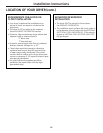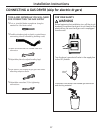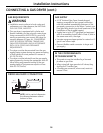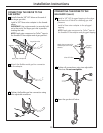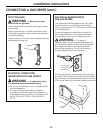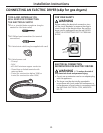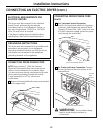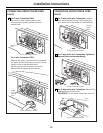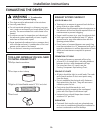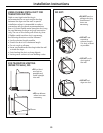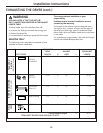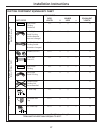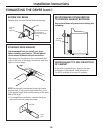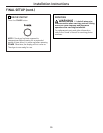
Installation Instructions
24
EXHAUSTING THE DRYER
WARNING – To reduce the
risk of fire or personal injury:
• This dryer must be exhausted to the outdoors.
• Use only metal duct.
• Do not terminate exhaust in a chimney, any gas
vent, under an enclosed floor (crawl space) or into
an attic. The accumulated lint could create a fire
hazard.
• Provide an access for inspection and cleaning of
the exhaust system, especially at turns. Inspect
and clean at least once a year.
• Never terminate the exhaust into a common duct
with a kitchen exhaust. A combination of lint and
grease could create a fire hazard.
• Do not obstruct incoming or exhausted air.
TOOLS AND MATERIALS YOU WILL NEED
TO INSTALL EXHAUST DUCT
❒ Phillips-head screwdriver
❒ Duct tape or duct clamp
❒ Rigid or UL-listed flexible metal 4″ (10.2 cm) duct
❒ Vent hood
EXHAUST SYSTEM CHECKLIST
HOOD OR WALL CAP
• Terminate in a manner to prevent back drafts or
entry of birds or other wildlife.
• Termination should present minimal resistance to
the exhaust airflow and should require little or no
maintenance to prevent clogging.
• Never install a screen in or over the exhaust duct.
• Wall caps must be installed at least 12″ above
ground level or any other obstruction with the
opening pointed down.
• If roof vents or louvered plenums are used, they
must be equivalent to a 4″ dampened wall cap in
regard to resistance to airflow, prevention of back
drafts and maintenance required to prevent
clogging.
SEPARATION OF TURNS
• For best performance, separate all turns by
at least 4 ft. of straight duct, including distance
between last turn and dampened wall cap.
For turns less than 4 ft. apart, see the
Ducting Component Equivalency Chart.
SEALING OF JOINTS
• All joints should be tight to avoid leaks. The male
end of each section of duct must point away
from the dryer.
• Do not assemble the ductwork with fasteners
that extend into the duct. They will serve as a
collection point for lint.
• Duct joints should be made air- and
moisture-tight by wrapping the overlapped
joints with duct tape or aluminum tape.
• Horizontal runs should slope down toward
outdoors 1/4″ per foot.
INSULATION
• Ductwork that runs through an unheated area
or is near air conditioning should be insulated to
reduce condensation and lint buildup.



